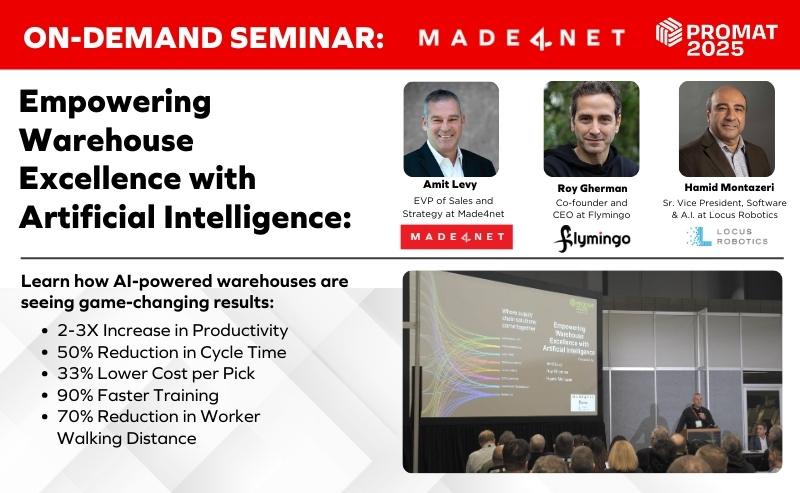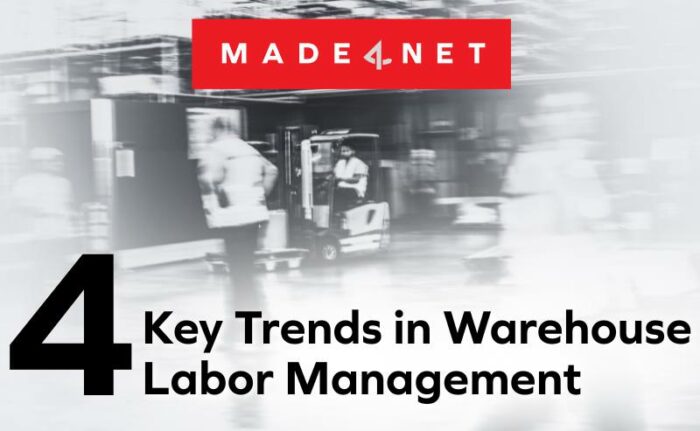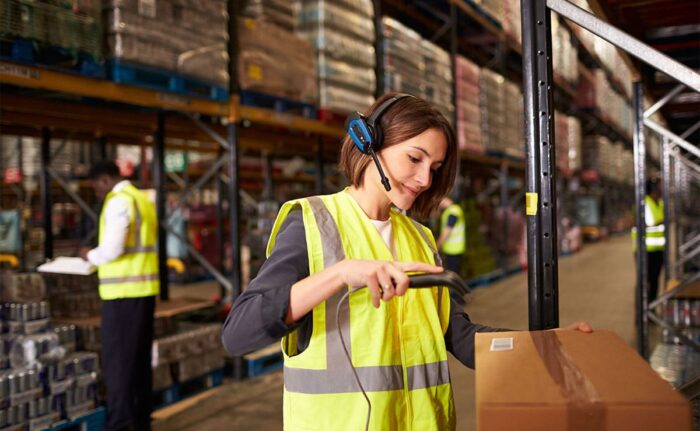
Technology is evolving at an unprecedented pace, transforming both our personal lives and the way we do business. When it comes to the warehouse, AI-driven automation is no longer a futuristic concept—it’s actively transforming operations, optimizing workflows, increasing productivity, and cutting costs. From AI-powered vision technology to intelligent robotics, these innovations are streamlining processes, enhancing efficiency, and unlocking new levels of operational excellence.
So, what does this mean for the future of the warehouse? During ProMat, Made4net joined forces with Flymingo and Locus Robotics to present: Empowering Warehouse Excellence with Artificial Intelligence to a packed house. During the session, we explored how AI is reshaping roles, improving efficiency, and setting the stage for the next generation of supply chain operations. Read on for key takeaways or watch the full session here:
AI in Our Daily Lives: The Foundation for What’s Next
Before diving into AI’s role in the supply chain, it’s important to recognize how deeply it has already integrated into our personal lives. From voice assistants that anticipate our needs to AI-powered recommendation engines that shape what we watch, read, and buy—automation is everywhere.
Amit Levy, EVP of Sales and Strategy at Made4net, kicked off Empowering Warehouse Excellence with Artificial Intelligence by sharing three bold assumptions:
- Any job that can be done via Zoom (or its equivalent) can be replaced by AI—and AI will eventually do it better.
- If AI benefits the business and saves costs, employers will replace human workers with AI-driven systems.
- Within five to ten years, AI will surpass human capabilities in many fields. In some areas, that’s already happening.
Fact is, the accelerating pace of AI development is surpassing expectations. A few years ago, researchers predicted that AI wouldn’t reach human-level proficiency for another 50 years. But as advancements like ChatGPT and other generative AI models emerge, those estimates are rapidly shrinking. Now, experts forecast that AI could reach widespread, human-comparable capabilities in as little as five years.
According to Levy, this shift challenges a long-held assumption: that human intelligence would always be our greatest competitive edge over machines. Historically, automation replaced physical labor, but critical thinking and problem-solving remained human domains. Now, AI is encroaching on cognitive tasks, forcing us to rethink our roles in the workforce.
As AI adoption accelerates, the question isn’t whether it will reshape industries—it’s how businesses can harness it for competitive advantage. In the supply chain, this transformation is already underway.
AI-Powered Vision Technology in the Warehouse
AI-Powered Vision Technology refers to the use of cameras, sensors, and artificial intelligence to enhance visibility, accuracy, and efficiency in warehouse operations. By leveraging machine learning and computer vision, this technology enables automated systems to “see,” interpret, and act on real-world data in real time.
Flymingo, a leading provider of AI-driven vision solutions, takes this innovation even further by seamlessly integrating with warehouse management systems (WMS), including Made4net’s WarehouseExpert, to create a fully connected, real-time digital twin of the warehouse.
How It Works
According to Roy Gherman, Flamingo’s Co-Founder & CEO, the company’s AI vision technology connects directly to a warehouse’s existing camera system—whether it’s one camera or 400—without the need for specialized equipment. Using its proprietary API, Flymingo fuses real-time WMS data with visual intelligence, ensuring every transaction in the WMS has a corresponding video record.
This means that every movement in the warehouse—whether it’s a worker picking an item, a pallet being moved, or a shipment being loaded—is tracked, analyzed, and verified. The system continuously monitors operations, identifies mismatches between what’s supposed to happen and what actually occurs, and proactively alerts teams when errors or inefficiencies arise.
The Power of a Digital Twin
Gherman explains that at the core of Flymingo’s solution is its AI-powered digital twin—a real-time, visual representation of warehouse operations. This enables businesses to:
- Monitor Operations in Real-Time – View every movement within the warehouse as it happens, without digging through security footage.
- Improve Accuracy & Reduce Errors – Instantly identify and correct issues such as misplaced inventory, misloaded shipments, or process deviations.
- Enhance Workforce Productivity – Track labor utilization, picking accuracy, and efficiency to optimize workflows.
- Proactive Alerts & Insights – Receive real-time notifications when exceptions occur, from a misrouted pallet to unexpected delays.
Solution in Motion: AI-Powered Vision Technology Transforms Coca-Cola’s Warehouses
Challenge:
Coca-Cola operates some of the fastest-moving warehouses in the industry, where precision and efficiency are critical. They needed a solution to improve quality control, reduce errors, and optimize warehouse operations without slowing down their high-speed workflows.
Solution:
Flymingo’s AI-powered vision technology was deployed across multiple Coca-Cola facilities, seamlessly integrating with their warehouse management system. By continuously monitoring operations and generating real-time alerts, the system identified and corrected errors before they became costly problems.
Results:
- 90% Reduction in Customer Complaints – By eliminating SOP deviations and errors, Coca-Cola significantly improved order accuracy.
- 70% Decrease in Truck Dwelling Time – Faster processing led to quicker load times and reduced delivery delays.
- 8% Increase in Productivity – Employees reached their quotas earlier, optimizing shift efficiency.
- Time Savings of 2 Hours Per Day – Fewer mistakes translated to faster workflows and reduced overtime.
- Significant Cost Savings – While exact figures remain confidential, the solution delivered over $500,000 in savings per site annually.
With five deployments completed and 25 more planned, Coca-Cola continues to scale its success, proving that AI-driven warehouse visibility isn’t just about tracking operations—it’s about transforming them.
Robots Are Getting Smarter in the Warehouse—And Why It Matters
Warehouse robots are evolving rapidly, thanks to AI-driven intelligence that enables them to navigate complex environments, interact with humans, and continuously optimize operations. According to Hamid Montazeri, Senior Vice President, Software & AI at Locus Robotics, “Autonomous mobile robots (AMRs) are no longer just programmed machines; they are now intelligent agents that can perceive, adapt, and make real-time decisions—all while working seamlessly alongside human employees.”
How AI is Making Robots Smarter
- Perception & Decision-Making – Robots use AI and sensors to map their surroundings, recognize obstacles, and autonomously adjust their paths for maximum efficiency.
- Goal-Driven Operations – AI enables robots to set and pursue goals, such as optimizing pick routes or avoiding traffic congestion in busy warehouse aisles.
- Collaboration with Humans – Modern robots are designed for augmented operations, meaning they assist human workers rather than replace them. AI allows them to anticipate worker movements and enhance productivity.
- Scalability & Adaptability – Robots can now be deployed in minutes, not days, allowing warehouses to quickly scale their workforce to meet demand spikes, such as during peak seasons.
- Data-Driven Optimization – AI-powered robots continuously learn from warehouse data, refining their routes, pick strategies, and workload distribution to improve over time.
The Business Impact: Why Smarter Robots Matter
Montazeri shares that companies implementing AI-powered AMRs are seeing game-changing results:
- 2-3X Increase in Productivity – Robots optimize workflows, speeding up order fulfillment.
- 50% Reduction in Cycle Time – Faster movement means quicker order processing.
- 33% Lower Cost per Pick – AI-driven efficiency slashes operational costs.
- 90% Faster Training – Employees can be up and running with robots in just 20-30 minutes.
- 70% Reduction in Worker Walking Distance – Less fatigue leads to happier, more efficient teams.
Unlocking the Future of AI-Powered Warehousing
The information shared and the technology showcased at ProMat demonstrated that AI is having a strong impact on the supply chain. AI-driven automation is no longer a futuristic concept—it’s transforming warehouse operations today. By optimizing key metrics like throughput, cost per pick, cycle time, order processing capacity, and exception handling, AI is helping warehouses achieve peak efficiency while reducing costs. As AI continues to reshape the industry, the question isn’t whether to adopt it—but how to use it to your advantage. Are you making the most of AI in your warehouse? We’re here to help ensure you do.
Get in touch with:


